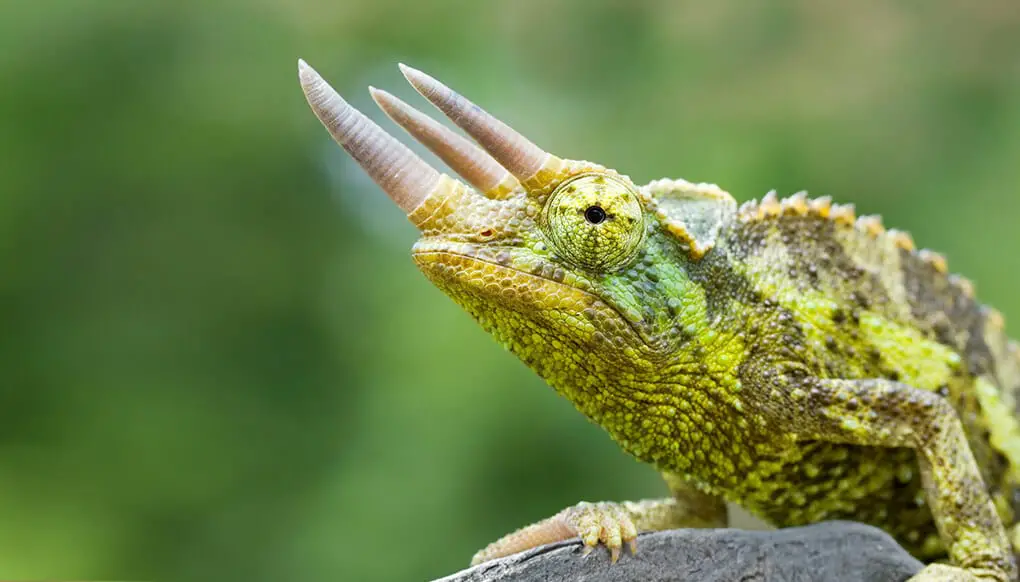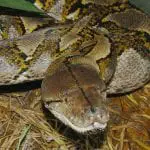Scientific Facts
| Common Name: | JACKSON’S CHAMELEON |
| Scientific Name: | (Chamaeleo jacksonii xantholophus |
| Life Span: | 5 to 10 years in captivity |
| Size: | 3 to 4 inches (hatchlings), 7 to 8 inches (adults) |
| Habitat: | mountain thickets and forests |
| Country of Origin: | East Africa |
Overview
Jackson’s chameleons were named after Frederick Jackson, an ornithologist, and were a governor of Kenya. Frederick Jackson was the first to carry out expeditions in Kenya. He collected several types of reptile species and birds.
Jackson’s chameleons came from Kikuyu, an ethnic group living in Kenya, so they are also called as Kikuyu 3 horned chameleon. They were found in East Africa but were introduced in Florida, Hawaii, and California. They look like a small Triceratops because of their three horns. This makes them very popular. They are, in fact, very successful in predating in spite of having sluggish and slow nature. They have a vision of 360 degrees and a tongue that attacks like lightning; thus, they spot and hunt small insects efficiently.
There are 3 types of Jackson’s chameleons, which are found in some parts of Africa. These are Trioceros subgenera. It includes the Chamaeleo jacksonii jacksonii found in Nairobi, Kenya, the C.j. merumonta in Mount Meru, Kenya, and C.j. xantholophus in Mount Kenya. The first one is about 4 inches; the second is about 3 inches while the last is 5 inches and is the largest. It has been in captivity since the 1980s.
All of Jackson’s chameleons are known to be docile. They are all for those who keep chameleons. They propagate easily and live-bearing. They are amazing. The young Jacksons have a brown color, which develops into bright green when they turn 5months. Males are brighter, having yellow and blue markings. Sometimes, they are called as the three-horned chameleons because of the males having small and brown horns found above their eyes and on the nose.
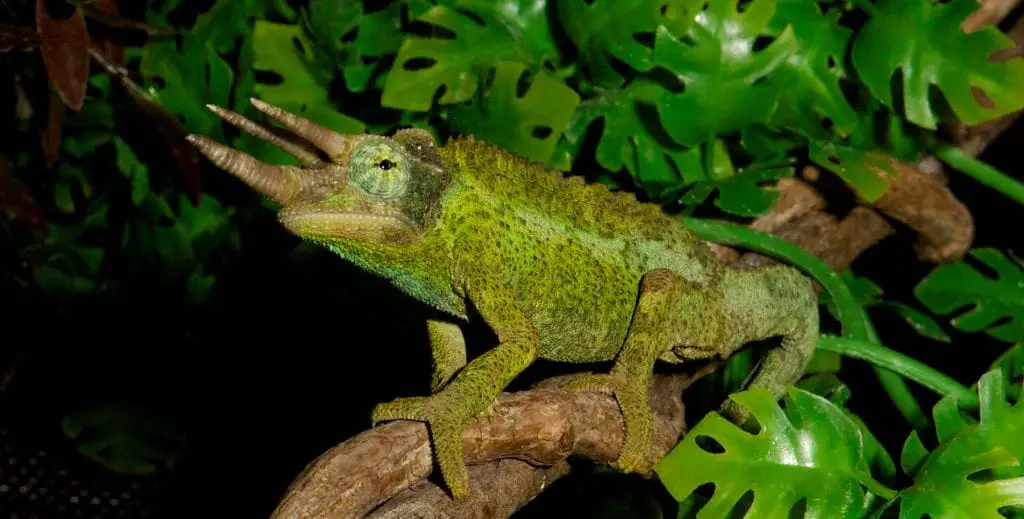
Physical Description
They are recognized for having three horns found on their snout. The two horns found above each of the eyes are termed as pre-ocular horns, while rostral horns for the one found on the nose. In terms of length, they are about 15 to 35 centimeters, but the females are smaller than the males who are of the same age. Male adults can grow as long as 38 centimeters, whereas females are just about 25 centimeters.
Normally, they display various shades of green, but in times of distress, it tends to turn black. Sexually, they are dimorphic. Males have 3 long and pointed horns that protrude from their heads, whereas females don’t have or almost not developed.
There is a small crest found at the back of their head and small pines along their vertebral line. To adapt to their life in the trees, they have zygodactylus feet. That means the 2 toes are pointed inward while the 3 points are pointed outward. They also have a prehensile tail, which they use to grip.
Among its other features, their eyes are really the most recognized. From the skin covering, only the pupil is visible. Each of their eyes rotates 180 degrees full, making 360 degrees for both eyes. Take note each eye is independent of the other eye. It means, one eye is for spotting prey, while the other is for scanning for threats. Their eyes are protected by an eyelid that is a single cone shape. When prey is spotted, the binocular vision determines the distance of prey exactly. Furthermore, they have strong control over their lenses, which lets them magnify something.
Another feature is their ability to notice ultraviolet light. They also make use of their tongue as their sensory organ. For instance, they can detect chemicals around them. Then it is transferred to Jacobson organ found on the roof of their mouth.
When it comes to hearing and smell, they are weak at it. As a result, they have a high dependence on their developed eyes. They can only hear small vibration, which comes from potential prey.
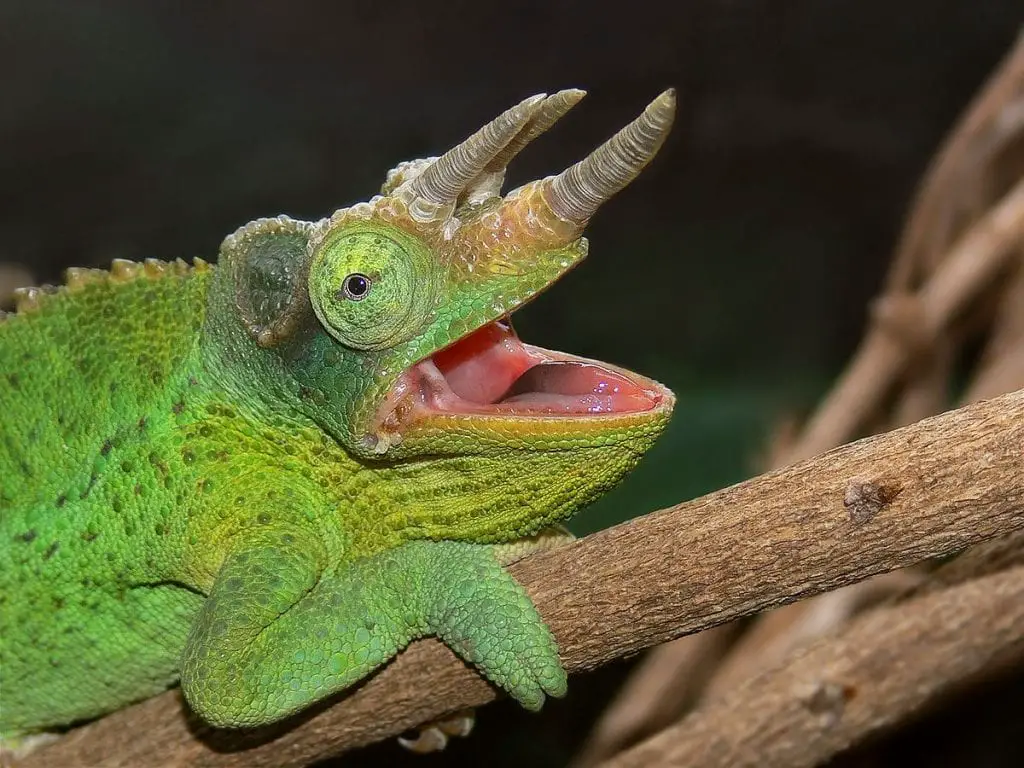
Subspecies
1) T. j. jacksonii
This is the nominate subspecies, also called Jackson’s chameleon. In terms of distribution, it has the largest. They can grow for about 8-10 inches. Both sexes have 3 horns, but females have smaller.
2) T. j. xantholophus
This was discovered in the Mount Kenya in 1988 and the commonly occurring subspecies of the T. jacksonii. Male adults are the largest, which can be as long as 14-15 inches. It is called the Yellow Jackson Chameleon because of its yellow crest.
3) T. j. merumontanus
This is the smallest. Male adults are just a few inches. For this reason, they are called as the Dwarf Jacksons chameleons. They are endemic to Tanzania in the Mount Meru. They have small and blue-green eyelids and yellow color on their heads. Their body is dark green.
Behavior
The males battle with their horns for territory. Horns are also used for attracting females. Once 2 males meet, each turn sideways, curl its own head, flattens its body, and thrust head forward. Then, to look bigger, they inflate themselves and come out with their brilliant colors. To display different colors inside, they open mouth with bobbing, hissing, and swaying.
The submissive one hides, freezes in one place, or escapes away. Its color turns into drab. When they fight, they poke using their horns and push from their branches. It can cause damage to them. Natural drab color and stillness are their methods to protect themselves from predators like birds, lizards, shrews, or snakes.
Jackson’s chameleon chooses to live alone except, of course when mating season comes. They are active at day time, which is spent on basking and hunting. They are not very territorial in spite of enough sources of food. When the female is prepared to mate, she changes her color, becoming bright green.
They communicate through gestures. To warn for threats around, bright colors are flashed. Their intelligence is of moderate level, as shown by their hunting techniques and mating rituals.
Size
For the hatchlings, they measure 3-4 inches in total length. Female adults are usually 7-8 inches, and males are 8-10 inches.
Life Span
Healthy males live longer than females for 8 to 10 years. The females live for 5 years approximately. When the females give birth, it makes them wear out after having 3 to four broods every year. Males are ideal as a pet for having a longer life.
Geographic Range
Jackson’s chameleons are found in East Africa, particularly in Tanzania and Kenya.
Food and Eating Habit
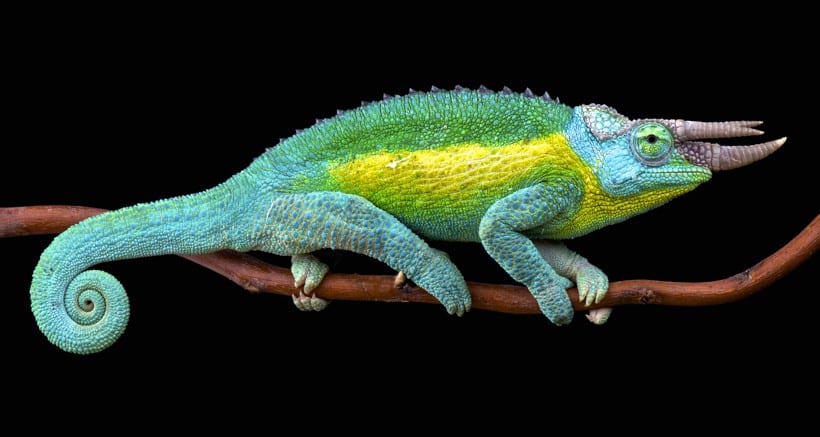
Jackson’s chameleons are mainly insectivores, including spiders, crickets, butter worms, wax worms, house flies, cockroaches, and small snails. Give them a various type of diet that is high quality and loaded with nutrition.
In the wild, they use each eye independently. Both eyes converge when prey is spotted, but before that, they bask under the sun. When they get warmed, that means they are ready to hunt.
They sway to get the exact distance of the prey. Then, the prey is captured. It is done by projecting their tongue that has fleshy tip having sticky saliva. The prey is taken back into their mouth, chewed, and then swallowed. Their tongue is 1 ½ longer than the length of the lizard and goes back to its normal state after a few seconds. They get water from lapping leaves that drop off.
In captivity, give 5 to 7 insects every feeding. Jackson’s chameleons tend to be sensitive when given too much Vitamin A. this leads to edema and gout.
Feeding
To attain good health for your chameleon, there are factors to consider like environmental, enough light, the right temperature, lots of water, and good nutrition.
How much should they eat?
- Their prey should not be bigger than the space between their eyes. This is to avoid choking. If you didn’t know, their eyes are too big for the stomach.
- Prey items should be no larger than the space between your chameleon’s eyes. By doing so, it will ensure that will not choke by accident.
- For babies who are one to three months old, you can feed them twice a day.
- For juveniles, three to six months old, feed ten to twelve small crickets every day.
- For sub-adults, six to twelve months give eight to ten medium crickets a day.
- For adults over a year old, give six to eight medium or large crickets a day after the other.
You can give super worms, waxworms, mealworms, butter worms once a week. Superworms have cancer-fighting peptides. Avoid giving newborn rodents, fireflies, and insects caught in the wild.
Lighting and Temperature
For daytime temperature, it should be 80 degrees F and 60 degrees F during the night. You can put a UVB light on top of your enclosure and a spot lamp to provide heat. Put branches to be used for basking 3-4 inches away from the screen located inside. Then the light housing should be 3 to 4 inches from the screen outside. This will prevent them from getting too near the light and avoid getting burned.
Put in mind that natural sunlight is essential for live-bearing. Some hours of sunlight charge them. Don’t let them unattended when outside. They could be under heat stress as indicated by the change in color, panting, or gasping. Put them in the shade.
Habitat
They live in the forest and mountain thickets. They live in tree branches and ventures rarely in the ground except when they lay eggs and mate. They have an arboreal type of lifestyle. They depend on their surroundings to keep their body temperature. They are cool-blooded.
In the morning sun, they bask. They get active after getting warmed and start to hunt. Their ability to change color is a perfect camouflage to find food.
Water
Jackson’s chameleon that is fully hydrated has full eyes, casque, and skin. Thus, it is important that you give them water before you feed to make sure that their tongue is functioning well and lubricated. During a rainstorm, they clean their eyes and hydrate fully. They puff their eyes out and rub them on branches. That is normal. That is their way to hydrate the skin and delicate their lungs
When they drink rapidly, don’t stop offering them water. Wait until they slow down or stop. Mist their body gently twice a day with water. Put them in the rainstorm once a week or put them in a shower on the plant half an hour weekly. When the temperature goes higher, they need more water. Adjust watering when needed.
Breeding
Jackson’s chameleon at nine months to one-year-old is ready to breed. Put the female into the male’s enclosure and let them mate for three days. Offer a rainstorm when the male seems disinterested or get another male and show him. Males become disinterested when they get familiar with the female that is housed next to them. Using another male will entice him to breed.
These chameleons are ovoviviparous. It means neonates are in a softshell incubated inside their mother. Gestation takes 7-9 months as the first brood. Another brood is born every 3 months when proper breeding comes. This is possible because of their ability to keep sperms. Reintroduce another female is good to keep the sperm’s count high.
Reproduction
They have a mating ritual. It is started by the male treating display towards the female. The male changes in color inflate the throat and raise the forelegs. The male circles the female grabs her neck toward his mouth and positions on her back. Then, inserts his hemipenis. This takes up to 13 minutes. The female can continue mating, but with another male.
Gestation takes 190 days. The mother gives birth in the morning. Eggs are delivered one at a time through the cloaca. They stay asleep until they touch the substrate. They break through the egg sac. Babies are 5.5 centimeters and weigh 6 grams. Mother chameleon copulates again.
Enclosure and Substrate
Housing your chameleons separately is ideal for reducing their stress. Use screen ages that are 3 feet tall by 2 feet square for each chameleon. They should be in a glass terrarium. They need ventilation from a mesh. Fiberglass or fine metals are not recommended. Vertical space is needed for climbing.
You may use potted plants with a plain paper as a substrate. Don’t use wood chips or other substrates that could be ingested.
Ficus benjamina tree nontoxic plants are suitable, plus sticks in different sizes and branches for climbing. Hibiscus, dracaena, and pothos may also be used. Artificial vines and plants are okay, as well. You can use paper towels for ground cover. You can also use an outdoor cage when the weather gets warm, but make sure it doesn’t overheat.
Take feces, leaves, or dead insects. Clean your enclosure once a month to prevent the growth of bacteria and molds.
Evolution
It is thought that these chameleons have similarities with iguanids and agamids. Anqingosaurus brevicephalus is the oldest chameleon that lived fifty to sixty million years in China. Its fossils were found in Kenya, showing that some chameleon species occurred in Eurasia and Africa. Researchers believe chameleons could have originated in Africa then they later migrated to Asia and Europe.
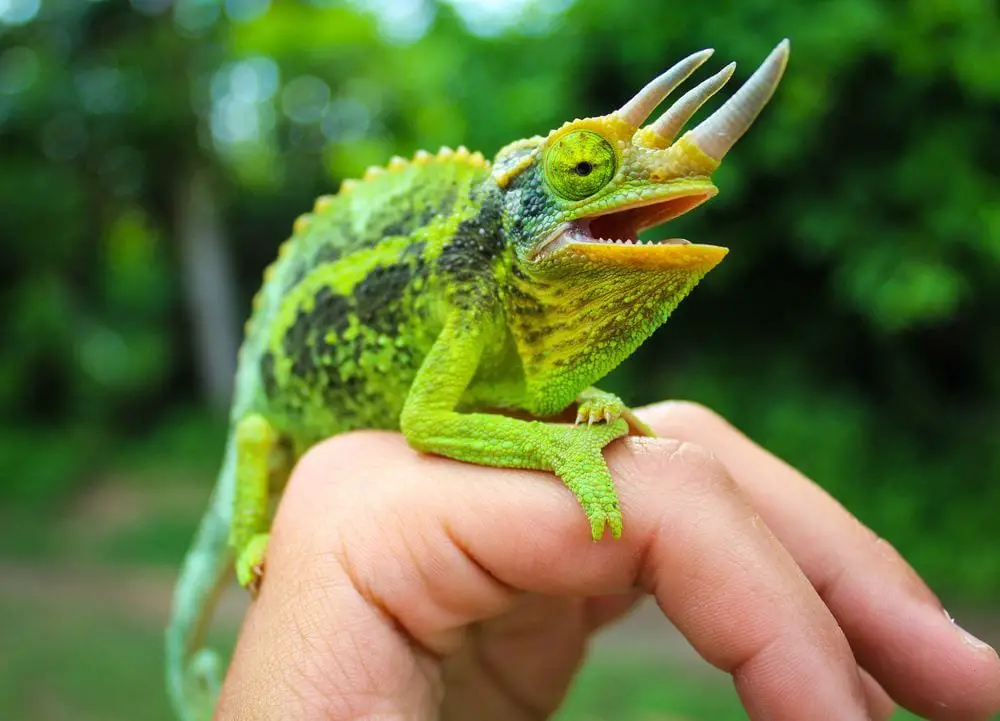
Availability: Where to Get One?
You can get one from reputable breeders found on the Internet or at some reptile expos and pet stores, of course. Most of these chameleons sold are captive bred.
Population and Conservation
These lizards are native to Tanzania and Kenya, and two subspecies are widely spread in the whole forests of Kenya. T. j. xantholophus are also spread rapidly in the whole of Hawaii. It is an invasive species there. They continue to flourish even in the wild. They come in a good survival rate. The IUCN listed T. jacksonii as the least concerned in the list of red endangered species.
How to Care
1) Housing
House only one adult in an enclosure. Males tend to fight and hurt each other. The size should be 18”x18”x36”. Ventilate the enclosure well. Put enough amount of branches as well as vines. Put pesticide-free plants.
2) Substrate
Paper towels are enough as bedding for easy cleaning and maintenance. Don’t use wood chips to avoid health problems.
3) Heating
There should be a gradient of temperature. For day time, it should be 75° to 83° F and 60° F at night.
4) Lighting
They need a full spectrum to be healthy. Change your bulb every six months to keep the UVA.
5) Shedding
Keep them fully hydrated for their shedding and health. Provide misting or shower weekly.
6) Water
Give a lot of clean water for drinking and keep humidity. Keep them water before they eat to have proper lubrication in their tongue and mouth.
7) Food
Insects like mealworms and crickets are best for them. Feed the young ones 5 to 7 insects.
8) Vitamins
Give crickets loaded with a gut.
9) Cage Maintenance
It requires maintenance minimally but washes the cage floor. Sanitize it and change paper towels once a week.
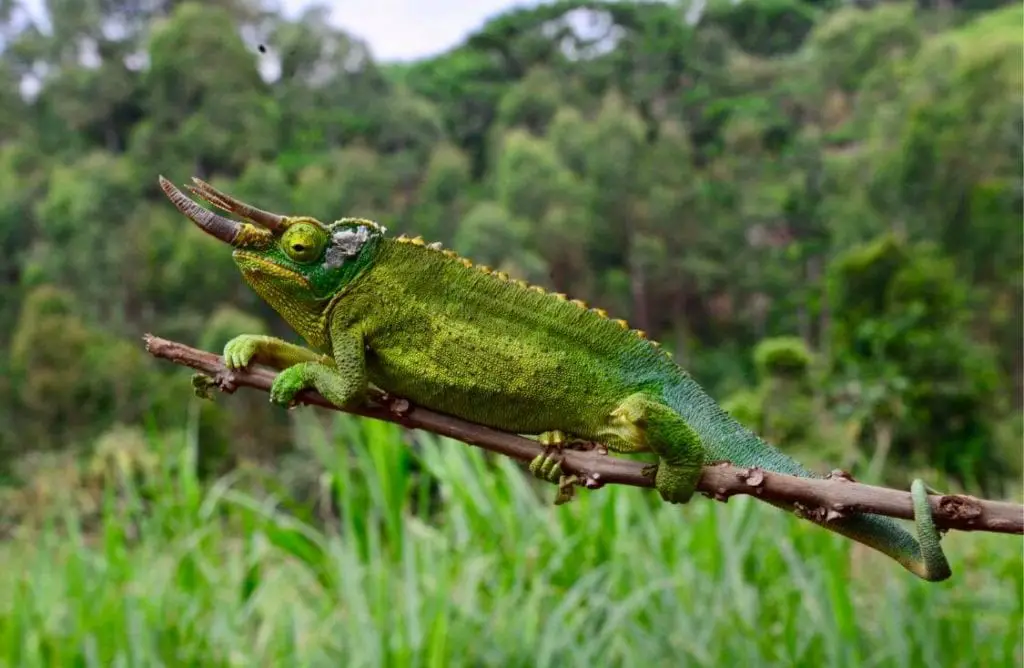
Common Health Problems and Prevention
1) Stress
They are easily stressed, and it can affect their immune system. Keep them too much handling and noise as well as from other chameleons. Don’t let them see a reflection of themselves. They might think it is another chameleon.
2) Upper Respiratory Infections
Signs are popping, too much mucus, gaped mouth, inflammation, and more.
Remove rubbish regularly, check for air quality and enclosure’s temperature.
3) Parasites
Keep their food and cage clean. Take them to a vet for testing and treatment
4) Kidney Failure and Gout
Dehydration for a long time is the main cause. Therefore, give them enough water to drink and mist. Watch for humidity level.
FAQ Section
What do Jackson chameleons need?
They need food and water. They need a humidity of 50-80 percent. Mist the plants in their enclosure.
How do you breed a Jackson chameleon?
They are ready for breeding at 9 months to 1-year-old. Put the female into the enclosure of the male. Let them mate for some hours or days.
Do female Jackson chameleons have horns?
The females have poor or no horns.
Can you hold a Jackson chameleon?
Don’t grab the chameleon out of their enclosure. This damages trust and cause injury to their ribs. Let them come to you in their own way and terms.
How often should I feed my Jackson chameleon?
Give them five to seven insects daily. For adults, feed them every other day.
Can you keep a male and female Jackson chameleon together?
Don’t house two males together, but you can put a male and even 2 to 3 females together for copulation.
Why is my Jackson chameleon black?
They change color as a response to social cues or temperatures. When they feel cold, they get dark to get more heat.
How long are Jackson chameleons pregnant?
It takes about 190 days.
Are Jackson chameleons endangered?
In Hawaii, they are invasive. They continue to flourish in the wild.
Do chameleons take care of their babies?
Most chameleon mothers don’t look after their babies after laying their eggs.
What color do chameleons turn when they die?
Before they die, they turn bright green and curls up. Then it gets dark and dies.
Do Jackson chameleons lay eggs?
Yes, they do. They lay eight to thirty babies.
Do chameleons recognize their owners?
It has been noticed that they have a memory making it for them to possibly recognize their owner, but they don’t have a wide spectrum of emotions like cats or dogs.
Do chameleons sleep?
Yes, they do. They climb on the branches or near the same spot they stay in the day time.
Are chameleons aggressive?
Generally, they don’t bite or hiss. When you pick them, they try to walk away. This depends on how the keeper raises them.
Are Jackson chameleons friendly?
Handling them then causes them stress, so you better just watch them than handling them.
Do female chameleons need a male to have babies?
After mating, the females keep sperm in their bodies. When they give birth, they have the ability to lay eggs again, even not mating with a male.

